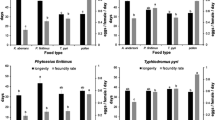Abstract
As it walks, the two-spotted spider mite Tetranychus urticae Koch (Acari: Tetranychidae) spins a trail of silk threads, that is followed by the predatory mite, Neoseiulus womersleyi Schicha (Acari: Phytoseiidae). Starved adult female N. womersleyi followed T. urticae trails laid down by five T. urticae females but did not follow a trail of one T. urticae female, suggesting that the amount of spun threads and their chemical components should correlate positively with the number of T. urticae individuals. To examine whether chemical components of T. urticae trails are responsible for the predatory mite’s trail following, we collected separate T. urticae threads from the exuviae and eggs, and then washed the threads with methanol to separate chemical components from physical attributes of the threads. Female N. womersleyi did not follow T. urticae trails that had been washed with methanol but contained physical residues, but they did follow the direction to which the methanol extracts of the T. urticae trails was applied. These results suggest that the predatory mite follows chemical, not physical, attributes of T. urticae trails.



Similar content being viewed by others
References
Croft BA, Slone DH (1997) Equilibrium densities of European red mite(Acari: Tetranychidae) after exposure to three levels of predacious mite diversity on apple. Environ Entomol 26:391–397
Dicke M, Sabelis MW, Takabayashi J, Bruin J, Posthumus MA (1990) Plant strategies of manipulating predatorprey interactions through allelochemicals: prospects for application in pest control. J Chem Ecol 16:3091–3118
Ehara S, Shinkaji N (1996) Principles of Plant Acarology. Zenkoku Noson Kyoiku Kyokai, Tokyo (in Japanese)
Hamamura T (1986) Studies on the biological control of Kanzawa spider mite, Tetranychus kanzawai Kishida by the chemical resistant predacious mite, Amblyseius longispinosus (Evans) in tea fields (Acarina: Tetranychidae, Phytoseiidae). Bull Fruit Tree Res Stn E 21:121–201 (in Japanese with English summary)
Hislop RG, Prokopy RJ (1981) Mite predator responses to prey and predator-emitted stimuli. J Chem Ecol 7:895–904
Hislop RG, Alves N, Prokopy RJ (1978) Spider mite substances influencing searching behaviour of the predator Amblyseius fallacies on apples. Fruit Notes 43:8–11
Hoy MA, Smilanick JM (1981) Non-random prey location by the phytoseiid predator Metaseiulus occidentails: differential responses to several spider mite species. Entomol Exp Appl 29:241–253
Jeppson LR, Keifer HH, Baker EW (1975) Mites injurious to economic plants. University of California Press, Berkeley
Margolies DC, Kennedy GG (1985) Movement of the two-spotted spider mite Tetranychus urticae Koch (Acari: Tetranychidae), among hosts in a corn-peanut agroecosystem. Entomol Exp Appl 37:55–61
McMurtry JA (1992) Dynamics and potential impact of generalist phytoseiids in agroecosystems and possibilities for establishment of exotic species. Exp Appl Acarol 14:371–382
Sabelis MW, Van de Baan HE (1983) Location of distant spider mite colonies by phytoseiid predators: demonstration of specific kairomones emitted by Tetranychus urticae and Panonychus ulmi. Entomol Exp Appl 33:303–314
Saito Y (1977) Study on spinning behavior of spider mites (Acarina: Tetranychidae). I. Method for quantitative evaluation of the mite webbing, and the relationship between webbing and walking. Jpn J Appl Entomol Zool 21:27–34 (in Japanese, with English summary)
Sokal RR, Rohlf FJ (1995) Biometry. The principles and practice of statistics in biological research, 3rd edn. Freeman, San Fransisco
Yano S (2008) Collective and solitary behaviors of the two-spotted spider mite (Acari: Tetranychidae) are induced by trail following. Ann Entomol Soc Am 101:247–252
Yano S, Osakabe Mh (2009) Do spider mite-infested plants and spider mite trails attract predatory mites? Ecol Res 24:1173–1178
Zemek R, Nachman G, Ruzickova S (2008) How does Phytoseiulus persimilis find its prey when foraging within a bean plant? In: Bertrand M, Kreiter S, McCoy KD, Migeon A, Navajas M, Tixier M-S, Vial L (eds) Integrative Acarology. In: Proceedings of the 6th european congress. European Association of Acarologists 2008, pp 390–393
Acknowledgements
We thank K. Oku of the National Agricultural Research Center, R. Uesugi of National Institute of Vegetable and Tea Science, and H. Iida of the National Agriculture and Food Research Organization for helpful suggestions. We also thank D. E. Bowler and other members in our laboratory for valuable suggestions. This study was partly supported by the Japan Society for the Promotion of Science [Basic Research C; grant number 21580066 to S. Y.], by funding for the development of new biorational techniques in sustainable agriculture, and by a Grant-in-Aid for the twentyfirst century COE program for Innovative Food and Environmental Studies Pioneered by Entomomimetic Sciences, from the Ministry of Education, Culture, Sports, Science, and Technology of Japan.
Author information
Authors and Affiliations
Corresponding author
Rights and permissions
About this article
Cite this article
Shinmen, T., Yano, S. & Osakabe, M. The predatory mite Neoseiulus womersleyi (Acari: Phytoseiidae) follows extracts of trails left by the two-spotted spider mite Tetranychus urticae (Acari: Tetranychidae). Exp Appl Acarol 52, 111–118 (2010). https://doi.org/10.1007/s10493-010-9356-x
Received:
Accepted:
Published:
Issue Date:
DOI: https://doi.org/10.1007/s10493-010-9356-x




